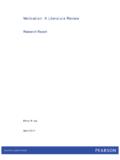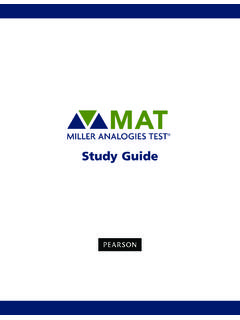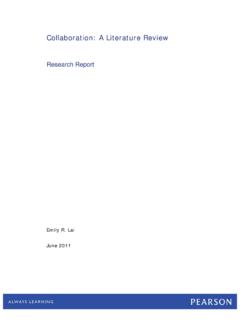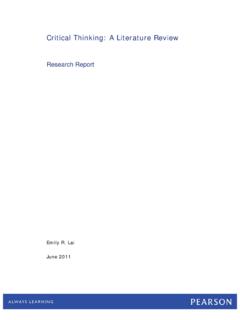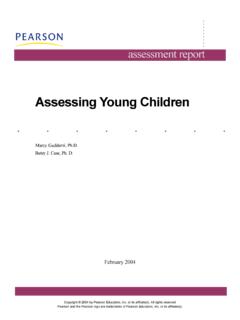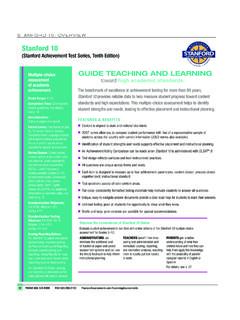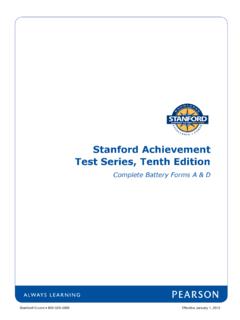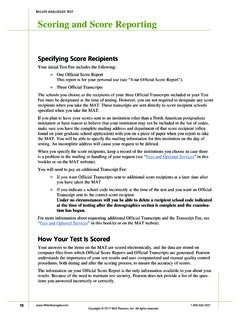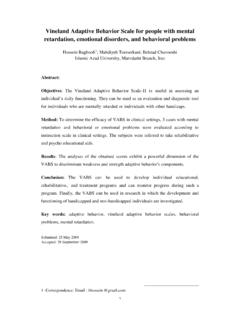Transcription of Patti L. Harrison Thomas Oakland Overview
1 1 adaptive behavior Assessment System II Technical Report Patti L. Harrison Thomas Oakland Overview The adaptive behavior Assessment System Second Edition (ABAS II) provides a comprehensive norm-referenced assessment of the adaptive skills of individuals ages birth to 89 years. The clinician can use the ABAS II to diagnose and classify disabilities and disorders; identify an individual s strengths and limitations; and to document and monitor the individual s performance over time. The ABAS II provides for the assessment of an individual by multiple respondents ( , parents, teachers, family members, the individual), evaluates function across multiple environments, and contributes to a complete assessment of the daily functional skills of an individual. The ABAS II is an invaluable tool in the assessment of individuals who may be experiencing difficulties with the daily adaptive skills necessary for functioning effectively in their environments.
2 When the goal of treatment is improving daily functioning and quality of life for an individual whose adaptive skill limitations are of concern; a comprehensive diagnostic assessment such as ABAS II is essential because it provides the analysis of strengths and weaknesses in adaptive functioning the clinician needs to develop the appropriate intervention s New in ABAS II ABAS II includes new features such as the infant preschool Parent/Primary Caregiver and Teacher/ Daycare Provider rating forms, normative data for children ages birth to five years, and an expanded structure that incorporates the current American Association of Mental Retardation (AAMR) guidelines for diagnosis of mental retardation. In addition to including younger age ranges and the AAMR guidelines, ABAS II retains all of the features of the first edition of ABAS. These include an assessment of overall adaptive functioning (the General adaptive Composite) and an assessment of the 10 adaptive skill areas specified by the Diagnostic and Statistical Manual of Mental Disorders Fourth Edition Text Revision (DSM IV TR; American Psychiatric Association, 2000).
3 ABAS II also retains the Parent and Teacher Forms for ages 5 21 years and the Adult Form for ages 16 89 years. The AAMR (2002) emphasizes the importance of evaluating conceptual, social, and practical skills when assessing adaptive behavior for diagnostic and intervention purposes. Significant limitations in adaptive behavior are defined as performance at least two standard deviations below the mean on either (a) conceptual, social, or practical adaptive functioning, or (b) an overall score on a standardized measure that assesses these three adaptive domains. In the table below, the 10 skill areas of the original ABAS have been conceptually grouped into the three broad domains according to AAMR guidelines. adaptive Domains Conceptual Social Practical Communication Functional Academics Self-Direction Leisure Social Community Use Home/School Living Self-Care Health and Safety Work Because federal and state governments and other professional associations ( , American Psychiatric Association) have not yet revised their policies to reflect AAMR policy recommendations ( , the use of conceptual, social, and practical skills in diagnosis, classification, and program planning), ABAS II retains the 10 skill areas and the General adaptive Composite (GAC)
4 From the first edition in order to provide standardized norm-referenced assessment of these skill areas, in addition to addressing the three broad domains of behavior advocated by the II Rating Forms The multidimensional quality of ABAS II is derived from five rating forms that can be used in combination with one another or separately. Each rating form comprises 193 to 241 items and can be completed independently by a respondent in about 20 minutes. The instructions and items can be read aloud to a respondent if he or she does not have the necessary reading skills to complete the form independently. The rating scale for the ABAS II items requires a respondent to indicate if the individual being assessed is able to perform an activity independently, and if so, how frequently (always, sometimes, or never) he or she performs the activity. 2 Rating Form Ages Setting Respondents Parent/Primary Caregiver Form 0 5 home and community parents or others responsible for the child s primary care Teacher/Daycare Provider Form 2 5 school or daycare teachers, teacher s aides, preschool instructors, daycare or other childcare providers Parent Form 5 21 home and community parents or others responsible for the child s primary care Teacher Form 5 21 school teachers, teacher s aides, or other school professionals Adult Form 16 89 home and community family members, professional caregivers, supervisors, or the individual Scores Reported The ABAS II normative data enable the clinician to obtain a normative comparison between an individual s adaptive behavior and the typical adaptive behavior of same-age individuals from a representative national sample.
5 Optional analyses provide for the identification of strengths and weaknesses in skill areas and comparison of scores for the adaptive domains. ABAS II provides: norm-referenced scaled scores for the 10 skill areas (M = 10, SD = 3) norm-referenced standard scores for the Conceptual, Social, and Practical adaptive Domains and for the GAC, including standard scores (M = 100, SD = 15), 90% and 95% confidence intervals and percentile ranks adaptive skill classifications of Extremely Low, Borderline, Below Average, Average, Above Average, Superior, and Very Superior which may be used for the skill areas, adaptive domains, and the GACS ample Items Sample Items Skill Area Infant-Preschool Forms School-Age And Adult Forms Communication Speaks in sentences of six or more words. Ends conversations appropriately. Community Use Asks to go to a park or other favorite place. Finds and uses a pay phone. Functional Academics Sings the alphabet song.
6 Makes reminder notes or lists. Home/School Living Turns TV on and off. Wipes up spills at home/school. Leisure Shows interest in mobiles or other moving toys. Plays alone with toys, games or other fun activities. Health and Safety Refrains from putting dirt or sand in mouth. Carries scissors safely. Self-Care Holds and drinks from a sipping cup. Uses public restroom alone. Self-Direction Resists pushing or hitting another child when angry or upset. Completes large home or school projects on time. Social Smiles when he/she sees a parent. Laughs in response to funny comments or jokes. Motor*/Work Shakes rattle or toy. Cares properly for work supplies and equipment. *Motor replaces the Work skill area on the infant-preschool forms. Psychometric Properties Standardization The five ABAS II forms were developed based on information gathered over eight years of research. Data collected during pilot and national tryout phases were analyzed to select items for the national standardization editions.
7 The standardization samples for the Parent/Primary Caregiver and Teacher/Daycare Provider Forms for children ages birth to five years comprised 2100 individuals; the standardization samples for the Parent and Teacher Forms, and Adult Form comprised 5270 individuals. The composition of the standardization samples were representative of the population in terms of the following variables: sex, race/ethnicity, geographic region, and parent education level These samples represented a continuum of development, including people with typically developing skills and people identified with a disability, in proportions representative of the general population ( Bureau of the Census, 1999, 2000). 3 Evidence of Reliability Reliability studies provide confidence and support for many application of the ABAS-II and are summarized as follows: All Forms Internal Consistency: Reliability coefficients for the GAC are in the high.
8 90s for all age groups, ranging from .97 to .99. Reliability coefficients for the adaptive domains are in the .90s, ranging from .91 to .98. Average reliability coeffi-cients of the skill areas across age groups are typically in the .90s, ranging from .85 to .97. Parent and Teacher Forms and Adult Form Test-Retest Reliability: Test-retest reliability coefficients of the GAC are all in the .90s. The mean GAC scores of the two testings (in a 1 2 week period) are very consistent, with the mean retest scores slightly higher. As expected, the test-retest reliability coeffi-cients of the 10 skill areas are slightly lower, mainly in .80s to .90s. Inter-Rater Reliability: (Teacher Form [ages 5 21] ratings by two teachers) Inter-rater reliability coefficients on the GAC scores are .91 for students between ages 5 and 9, .87 for students between ages 10 and 21, and .89 for students of all ages. The inter-rater reliability coeffi-cients for the skill areas generally are in the.
9 60s and .70s. (Correlations corrected for variability in sample.) Inter-Rater Reliability: (Parent Form [ages 5 21] ratings by both parents) The inter-rater reliability coefficients on the GAC scores are .83 .85 for both age groups (ages 5 11 and 12 21). The inter-rater reliability coefficients for the skill areas generally are in the .60s and .70s. (Correlations corrected for variability in sample.) Inter-Rater Reliability: (Adult Form ratings by two adult respondents) The inter-rater reliability coefficients on the GAC scores are .90 without Work and .93 with Work. The inter-rater reliability coefficients for the skill areas generally are in the .80s. (Correlations corrected for variability in sample.) Cross-Form Consistency: (Parent and Teacher Forms [ages 5 21]) The correlation between the teacher and parent rating is .70 for GAC. The mean scores differ by approximately 1 point. The correlation coefficients for the skill areas generally are in the.
10 60s and .70s. Mean scores differ by less than 1 scaled score. (Correlations corrected for variability in sample.) Cross-Form Consistency: (Adult Form self-report and rated by other respondents) The correlation between self-ratings and ratings by others is .94 for the GAC without Work and .88 for the GAC with Work. The mean scores differ by approximately 1 point. The correlation coefficients for the skill areas generally are in the .80s. Mean scores differ by less than 1 scaled score. (Correlations corrected for variability in sample.)Evidence of Validity The correlation between the school-age Teacher Form GAC and the vineland adaptive behavior Scales Classroom Edition (VABS) adaptive behavior Composite is .82. Furthermore, all scores from nine ABAS skill areas and the three VABS subdomains correlate significantly (p < .01). For example, the two scales that assess communication correlate .76. ABAS II includes additional validity studies with the vineland adaptive behavior Scales Interview Edition and with other adaptive behavior assessment instruments designed for children younger than 5 of Clinical Validity Clinical validity studies support the use of the ABAS-II with clients with a variety of problems and disorders.
